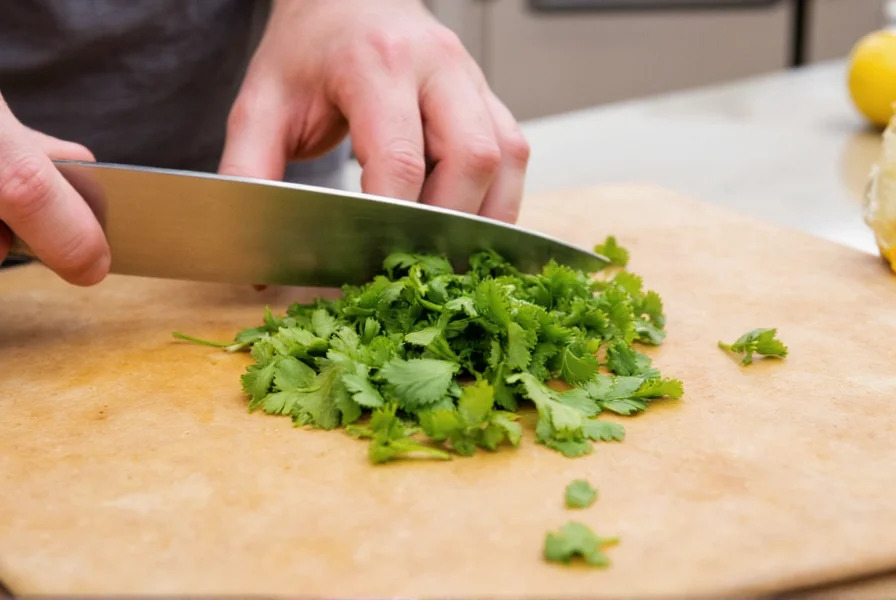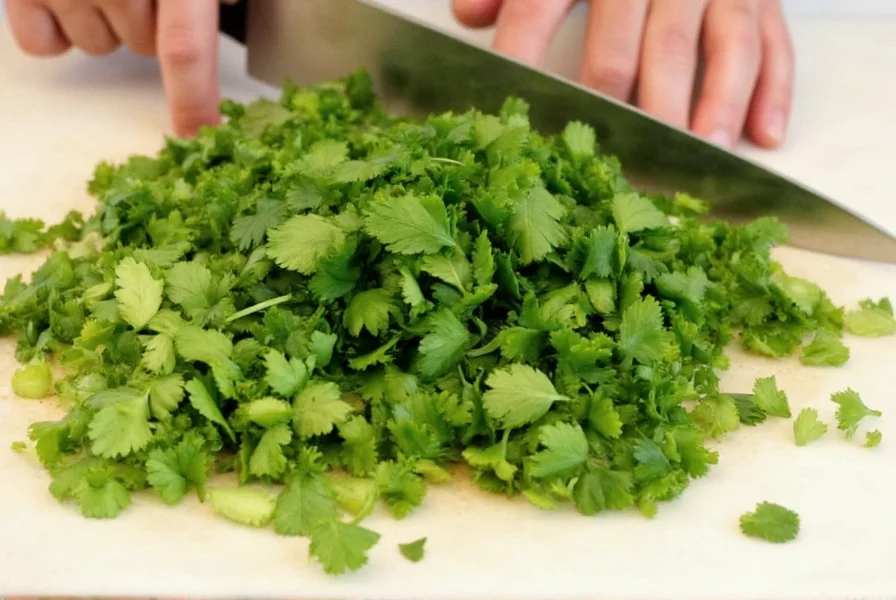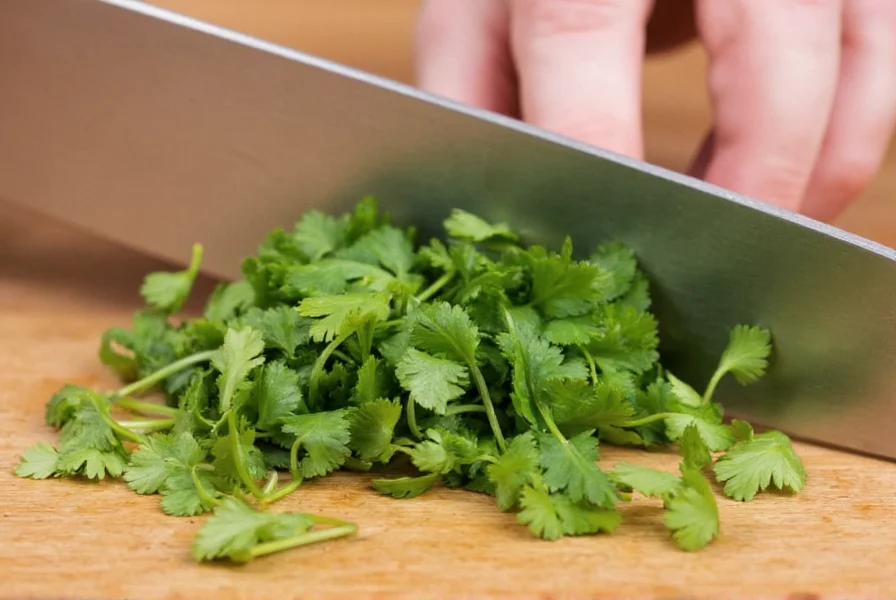Chopping coriander properly makes a significant difference in both the flavor and presentation of your dishes. Many home cooks struggle with this simple task, resulting in bruised, browned, or unevenly chopped herbs that lose their vibrant flavor. Understanding the proper technique for chopping fresh coriander can elevate your cooking from ordinary to exceptional.
Why Proper Coriander Chopping Technique Matters
Coriander, also known as cilantro, contains delicate essential oils in its leaves that provide its distinctive fresh, citrusy flavor. When you chop coriander incorrectly, you risk:
- Bruising the leaves, causing them to turn brown and bitter
- Releasing too many enzymes that accelerate spoilage
- Creating uneven pieces that cook at different rates
- Losing valuable flavor compounds through oxidation
Professional chefs know that how you handle fresh herbs directly impacts the final dish. The proper chopping technique maximizes flavor while maintaining the herb's vibrant green color and delicate texture.
Essential Tools for Chopping Coriander
Before learning how to chop coriander effectively, ensure you have the right tools:
| Tool | Why It Matters | Alternative |
|---|---|---|
| Sharp chef's knife (6-8 inch) | Clean cuts preserve flavor; dull knives crush leaves | Sharp paring knife |
| Stable cutting board | Prevents slipping and uneven chopping | Wooden board (avoid glass) |
| Moist paper towels | Keeps coriander fresh during prep | Damp kitchen cloth |
| Small bowl of ice water | Revives wilted coriander | Cold water rinse |
Step-by-Step Guide: How to Chop Coriander Properly
Step 1: Prepare Your Coriander
Start with fresh coriander that's crisp and vibrant green. Remove any yellowing or wilted leaves. Fill a large bowl with cold water and submerge the coriander to remove dirt and debris. Gently swish the herbs, then lift them out (don't pour into a colander, which transfers dirt back onto the leaves). Repeat if necessary.

Step 2: Dry Thoroughly
This critical step is often overlooked when learning how to chop coriander without bruising. Excess water causes slipping and dilutes flavor. Use a salad spinner for best results, or lay leaves between clean kitchen towels and gently press out moisture. Never skip this step—wet coriander won't chop cleanly.
Step 3: Separate Leaves from Stems
While thin, tender stems can be chopped with the leaves, thick lower stems are bitter. Hold the coriander bunch upside down and run your fingers from the leafy top down toward the base, stripping off the leaves. Reserve tender upper stems for chopping; discard thick lower stems or save for stock.
Step 4: The Proper Chopping Technique
This is where most people go wrong in their coriander preparation. Follow these precise steps:
- Gather the washed, dried leaves into a compact pile on your cutting board
- Hold the bunch firmly with your non-knife hand, curling fingers inward for safety
- Place the knife tip on the board and use a rocking motion from tip to handle
- Make quick, confident cuts—don't saw or press down hard
- After 3-4 chops, rotate the pile 90 degrees and repeat
- Stop when pieces reach your desired size (typically 1/8 to 1/4 inch)
Step 5: Finishing Touches
For the best results when chopping fresh coriander, transfer chopped herbs immediately to your dish or storage container. Avoid leaving chopped coriander sitting on the cutting board, as exposure to air causes rapid flavor degradation. If your recipe calls for minced coriander, make one final pass with the knife, gathering the pile and chopping in the opposite direction.
Common Mistakes to Avoid When Chopping Coriander
Even experienced cooks make these errors when preparing coriander:
- Using a dull knife - Crushes rather than cuts, releasing bitter compounds
- Over-chopping - Turns leaves to mush, accelerating oxidation
- Chopping too far in advance - Flavor degrades within 15-20 minutes
- Using a food processor - Almost always over-processes delicate leaves
- Not drying properly - Causes slipping and uneven chopping
When to Use Different Chopping Styles
The best technique for chopping coriander varies by recipe:
- Fine chop (1/8 inch) - Ideal for salsas, chutneys, and marinades where even distribution matters
- Medium chop (1/4 inch) - Perfect for curries, soups, and rice dishes
- Rough chop (1/2 inch) - Best for garnishing tacos, salads, or grilled meats
- Whole leaves - Use for delicate dishes like ceviche where texture is important
Storing Chopped Coriander Properly
If you must prepare coriander in advance, follow these storage tips to maximize freshness:
- Place chopped coriander in an airtight container lined with damp paper towels
- Store in the refrigerator for no more than 4-6 hours for best flavor
- Never store chopped coriander in water (dilutes flavor)
- For longer storage, freeze whole leaves in ice cube trays with water or oil
Remember that freshly chopped coriander always provides superior flavor. The proper technique for chopping fresh coriander ensures you get the most vibrant flavor possible for your dishes.

Advanced Tips for Perfect Coriander Every Time
Professional chefs use these techniques when chopping coriander for restaurant-quality results:
- The ice water revival - If coriander looks slightly wilted, soak in ice water for 10 minutes before chopping
- Chill your tools - Cold knives and boards help preserve volatile flavor compounds
- Work quickly - Complete the chopping process within 2-3 minutes of washing
- Add acid last - When making salsas, add lime juice after chopping to prevent premature breakdown
- Use immediately - For critical dishes, chop coriander tableside for maximum aroma
FAQ: Common Questions About Chopping Coriander
Can I use a food processor to chop coriander?
While possible, food processors typically over-process delicate coriander leaves, turning them brown and bitter. The blades generate heat and crush rather than cut the leaves. For best results when learning how to chop coriander properly, use a sharp knife with the rocking technique described above. If you must use a processor, pulse just 2-3 times with extremely cold blades and immediately transfer to your dish.
Why does my chopped coriander turn brown so quickly?
Chopped coriander turns brown due to oxidation and enzymatic browning when cell walls are broken. This happens most often when using a dull knife (which crushes rather than cuts), over-chopping, or leaving chopped coriander exposed to air. To prevent this when chopping fresh coriander, use a sharp knife, chop minimally to your desired size, and use immediately. Chilling your knife and board before chopping also slows this process.
Should I include the stems when chopping coriander?
Only the tender upper stems should be included when chopping coriander. The thick lower stems contain different compounds that are more bitter and woody. When preparing coriander, strip the leaves and tender upper stems from the tough lower stems. You can chop the tender stems along with the leaves, but discard the thicker lower portion or save it for making vegetable stock where the bitterness won't be noticeable.
How far in advance can I chop coriander before using it?
For optimal flavor, chop coriander immediately before adding it to your dish. The essential oils that give coriander its distinctive flavor begin degrading within 15-20 minutes of chopping. If you must prepare in advance, store chopped coriander in an airtight container with damp paper towels in the refrigerator for no more than 4-6 hours. Even with proper storage, you'll notice significant flavor loss compared to freshly chopped coriander.
What's the difference between chopping and mincing coriander?
Chopping coriander typically produces pieces about 1/4 inch in size, while mincing creates much finer pieces (1/8 inch or smaller). The proper technique for chopping fresh coriander involves gathering leaves and making rocking knife motions, while mincing requires additional passes with the knife, often changing direction. Mincing releases more flavor but also accelerates oxidation. Use minced coriander for dishes requiring even flavor distribution like marinades, and chopped for garnishes where texture matters.











 浙公网安备
33010002000092号
浙公网安备
33010002000092号 浙B2-20120091-4
浙B2-20120091-4